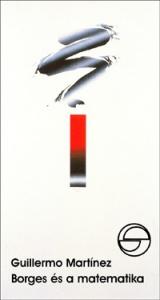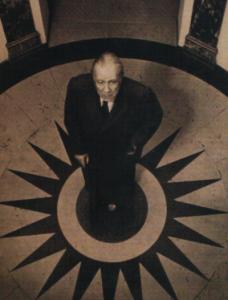Borges and the Beauties of Mathematics
Alfred Rényi the grandson of Alexander Bernát and the author of several works popularizing mathematics said the following: “In a certain sense mathematics has always played the role of a connecting link between different sciences as well as between science and art [...] At the same time, I think, it is mathematics of all sciences that is closest to arts.” The same thought appears in Borges and Mathematics by Guillermo Martínez, one of the two books on Borges published recently by Europa Publishing House. However, compared to Edwin Williamson’s monograph, in Maretínez’s work the protagonist is not Borges but rather the intersection of mathematics and aesthetics, of mathematics and literature.
Yet, besides this convergence we are still able to speak about the diversity of its genres and themes as well. There are lectures, interviews, annotations, presentations as well as book reviews; moreover the documentation of the submission of a mathematical(-historical) hypothesis’; yet all in all it is rather the essay that dominates the volume. Half of the text covers the two-piece title lecture and hereinafter I am going to attempt to study it in more details.

The opening piece is imperfect but to give Martínez his due he also acknowledges the faults of the lecture. He does not even manage to reach the end of his message and since his primary goal is to make people understand mathematics, even those who have not got the faintest idea of it, he is inevitably unable to do more than to make a slight opening on the hard shell of mathematical theories when acknowledging he does not keep to that strict precision required from true mathematicians. Unfortunately it leads to entirely offensive distortions in his book many times.1 Besides he also admits that his standpoint inevitably distorts his subject, and “he finds himself caught in the quicksands of interpretation”.
He is also aware that the mathematical elements in the works of Borges “ are [...] molded and transmuted into >> something else<<”, into style, into literature. However, at the same time, he does not lay enough emphasis on the fact that mathematics is also the instrument of magic, and he does not mention Borges’ most characteristic subject matter, the “mystical permutation”, according to which every possible variation occurs in perpetual returning (see primarily his poems and prose poems such as Alexandria, 641. A. D. and The Plot). His redundant yet related subjects are sometimes discussed separately and far from each other. In short: they are informal lectures.
Instead of collecting the mathematical motives found in the works of Borges he leads us to another publication, unfortunately, not translated into Hungarian yet, and carries out the classification of these motives by collecting them in three archetypes on the basis of The Aleph, a comprehensive short story. These three types are the following: the infinite and the infinites; the “sphere whose center is everywhere and circumference nowhere”; and the mathematical auto-reference that is the problem of “self-reference”. (The latter concept comprises those paradoxes and peculiarities that follow from an object containing itself or referring to itself.) As an addition to Martínez’s message we might state: the mutations of these three topoi can be traced back to the same primordial source. Since this particular sphere “whose center is everywhere and circumference nowhere” is nothing else but a kind of infinite, in which the whole can be the part of its own self.

In connection with the second lecture, again we could speak about a threesome and this “trinity” springs from the same root. Here we study the correspondences between mathematics and the creative procedure of artistic creation. First, the issue of universal vs. particular emerges, the relationship between abstraction and representation: “When Borges writes, he typically accumulates examples, analogies, related stories, and variations on what he wants to tell” (see the aforementioned permutations and mutations). Not only the examples or variations of a topic appear in Borges’ works but also its different versions that are getting gradually more abstract. According to Martínez this technique of the author can be compared to scientific abstraction or concept formation.
Between the parallels of mathematics and the literary work of Borges (and all art in general) it is the aesthetic of the mathematical argumentation that could be mentioned secondly, but Martínez does not waste time on it does not even devote a separate section to discussing it, instead, he rather introduces it in a distinct, independent essay. As he says in his lecture: „Mathematicians do not just accept any arguments. The final result is not irrelevant because they do keep certain aesthetic considerations in view. In mathematics you cannot simply accept any solutions to be a good solution; to a certain extent it should be beautiful…”2

The last topic of the lectures and, at the same time, our third point is “the short story as a system of logic”. Here, the lecturer points out that the pairs invention /ingenuity and logic/reason are both in need of each other’s support, be it the process of creating a literary work or the formation of a mathematical corroboration. In order to understand the difference, which is seemingly unambiguous, we have to refer to one of the observations of the first lecture again: “What is the difference? That in mathematics there are formal protocols under which the truth that the mathematician wishes to communicate can be demonstrated step by step from principles and “ground rules” that all mathematicians agree on. The demonstration of the value of an esthetic work is not so straightforward, however”. It seems, these differences do not get sufficient emphasis.
Most of the ensuing writings can be considered an appendix to what has already been delivered and the problems concerned in the first part will be revealed in the rest that follows. From this point of view two of the articles Martínez mentioned in the lecture is unfortunately missing: “Borges and Three Paradoxes of Mathematics” (“Borges y tres paradojas matemáticas”), as well as “Returning to 'The Aleph'” (“Un regreso a 'El Aleph'”)
This book by Martínez, despite its very inaccuracies and “inadequacies”, relying on Borges’ art emphasizes, and by all means successfully, that the parallels of mathematics and literature do not only meet in the infinite. Moreover, we might say their relationship is well-founded on the basis of their aesthetic nature.
Guillermo Martínez, Borges and Mathematics. Budapest, Europa, 2010. Translated by Mercédesz Kutasi.
translated by Lili Kunfalvi
1 I would definitely like to refer to a blog which contains an entirely direct correction.
2 He continues discussing this topic in his essay “Resolutions and Disappointments” and adds to what has already been said: in mathematics a difficulty of aesthetic nature is to take form, for computers are already capable of producing solutions to problems that no human being has been able to – though these solutions would be unacceptable to all mathematicians particularly due to the criterion of beauty present in them.



Facebook-hozzászólások